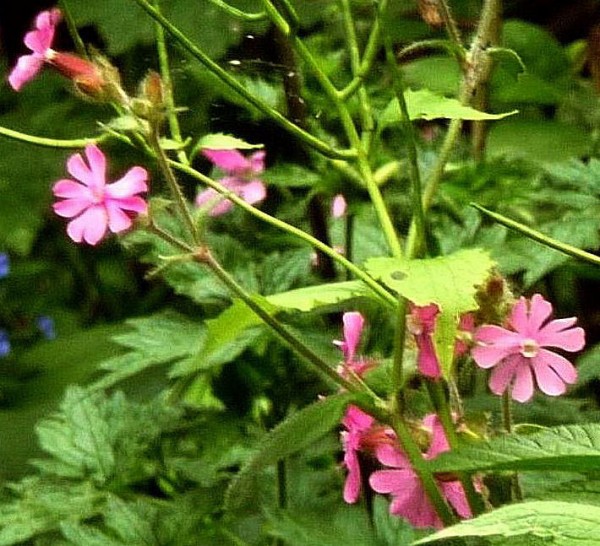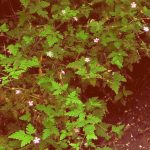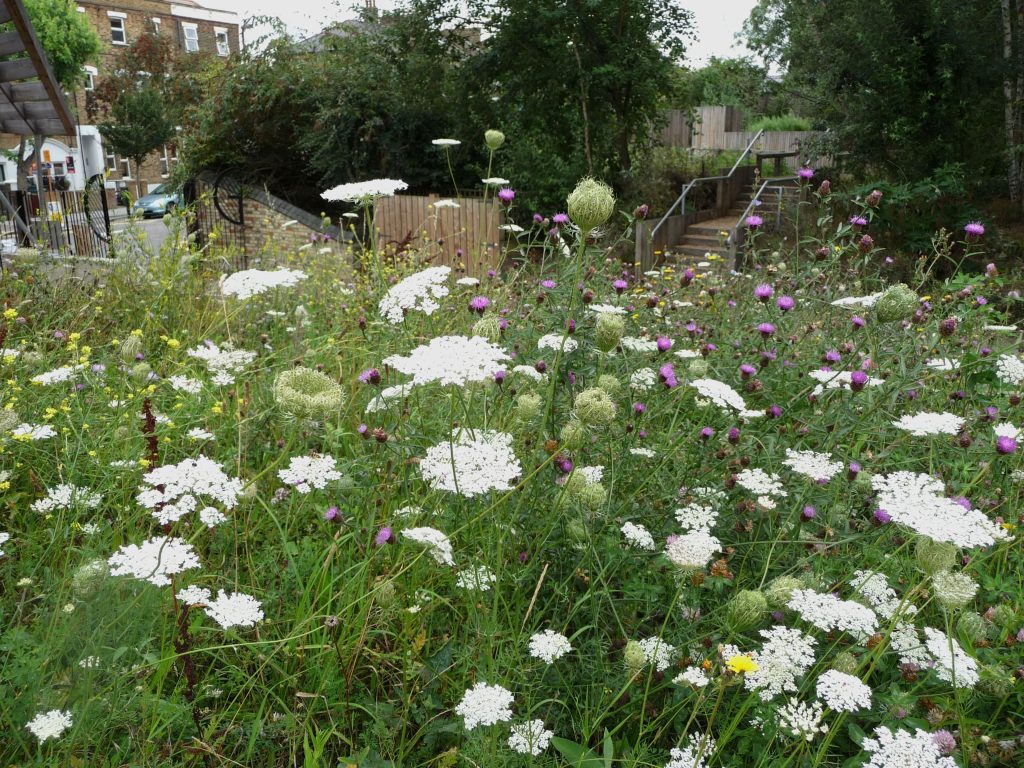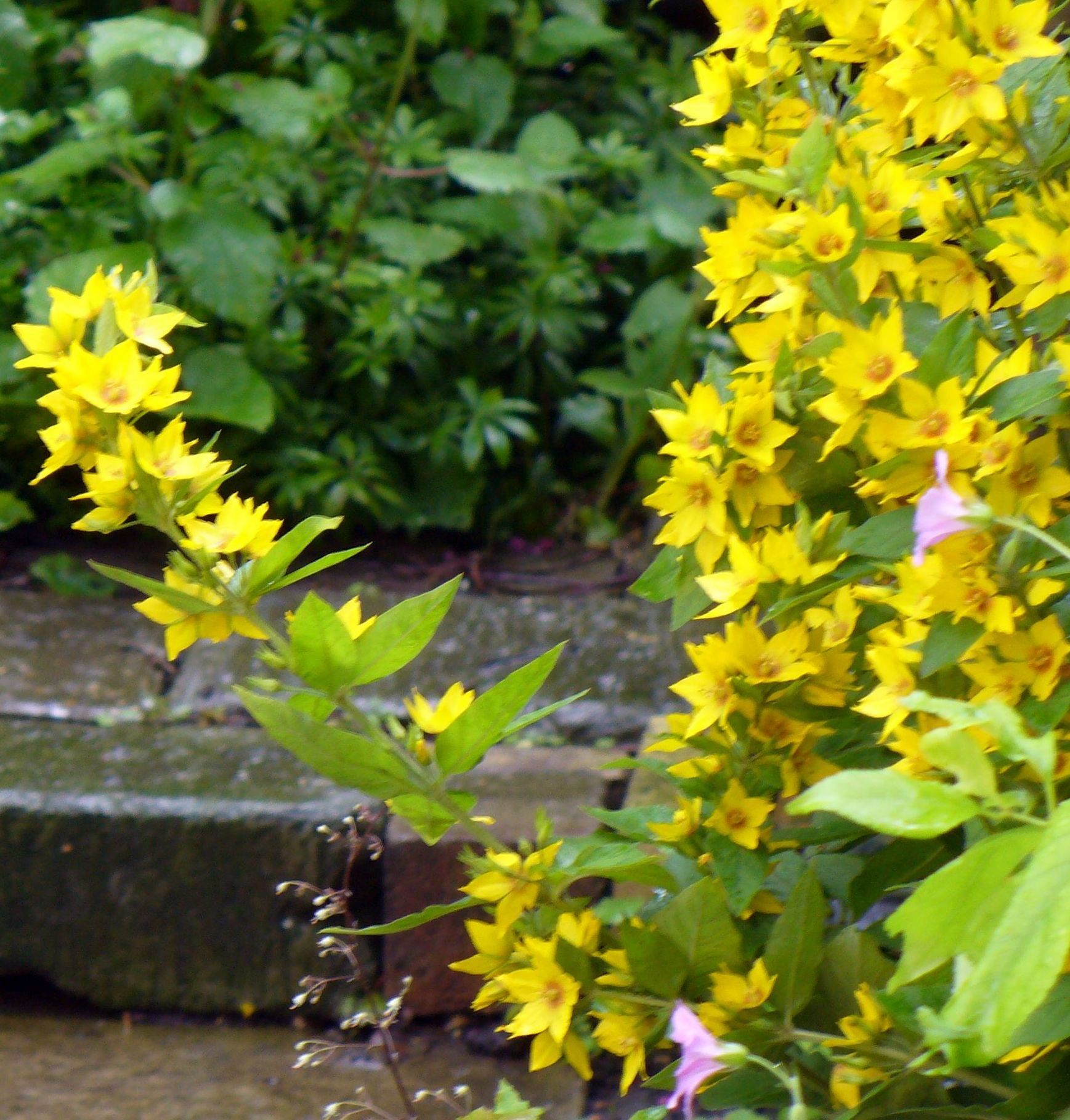Bee’s Favourites and other Native Wildflowers
 Alkanet  Hedge Woundwort  Small Scabious  Purple Loosestrife |
Wildflowers may be known by several names, some acquired over centuries. Plants’ names may differ from one part of the country to another; a British wildflower growing abroad may have another name. Learning the plant’s Latin name helps to avoid confusion.Part of the pleasure of growing a native wildflower is knowing it has lived a life and earned itself a reputation, and perhaps a folkname or two. When someone asks you, ‘What’s this one, then?’ you can answer ‘Kiss Me Quick’, or ‘Viper’s Bugloss’. ‘Mind Your Own Business’ (Soleirolia soleirolii), a carpeting plant from the Mediterranean, grows in many of our gardens. Some prefer to call it by one of its other names, ‘Baby’s Tears’ or ‘Paddy’s Wig’, to avoid misunderstandings. |
These native wildflowers, with a few exceptions, have attracted the insects to our garden: honeybees, bumblebees, hoverflies and others. Bees are having a desperately hard time right now, and anything we can do to encourage them is worth doing. Because of the cold winter and wet spring, bee numbers were down in 2013, with some wildflower favourites not visited by bees at all.
|

BETONY (Stachys officinalis)Betony’s LAVENDER flowers bloom from June till September; they are visited for their nectar by bees and other insects, including the Brimstone butterfly. Also known as Bishopswort, Betony’s properties are both medicinal and magical. Used in herbal teas and herbal tobacco, a poultice of its leaves was used on wounds, bites and poisonous stings, and it was inhaled to treat bronchitis. “A religious herb of the Celts, also native to temperate Europe and Algeria, and known to the ancient Egyptians…” “Grown in physic gardens of apothecaries and monasteries for medicinal purposes as well as churchyards to foil evil spirits who might be hanging around. …also worn about the neck as an amulet or charm to drive away devils and despair (probably quite common in the bleak Middle Ages.)” Italian proverb: ‘Sell your coat and buy Betony’. Website: (earthnotes.tripod.com/betony/htm) cop, 2006 by Ernestina Parziale, CH… |

BIRDSFOOT TREFOIL (Lotus corniculatus)
This wildflower is a member of the pea family and an important plant for wildlife. Its flowers are visited by many insects for pollen and nectar; its leaves are foodplants for the Silver-studded Blue Butterfly and the Six-spot Burnet Moth. Planted for erosion control, Birdsfoot Trefoil has acquired many folknames: Boots-and-Shoes, Cat cluke, Cat-poddish, Cheesecake, Crow-foot, Crowtaes, Cuckoo’s Stockings, Devil’s Claws, Eggs-and-Bacon, God Almighty’s Thumbs-and-Fingers, Ground Honeysuckle, Lady’s Glove, Lamb’s Sucklings, Milkmaid, Patten and Clogs, Pig’s Pettitoes, Sheepfoot and Venus’s Shoe. Botanical painting by J.N.Fitch, Horwood’s British Wildflowers in their Favourite Haunts |
BITTERSWEET (Solanum dulcamara)
The pollinated flowers become RED berries, which are poisonous. In some of the nearby Highbury gardens, it makes a handsome free-standing shrub. One of its other names is Woody Nightshade. |
|
|
CAMPION – White (Silene alba)
|
CLOVER – Dutch or White (Trifolium repens)
Years ago, clover planted in a windowbox, on the top floor of the house, was found by mice, who may have been driven out of the little woodland at the back when a developer chopped it down… every last morsel of it was eaten. This, our current clover patch, grows in a ceramic pot. |
|
|
Introduced to the UK before the Iron Age, its petals were churned into butter and added to cheese to intensify the yellow colour. We have had it here in the wildlife garden; it glows in the sunshine. http://www.bestwood-country-park.co.uk/corn marigold |
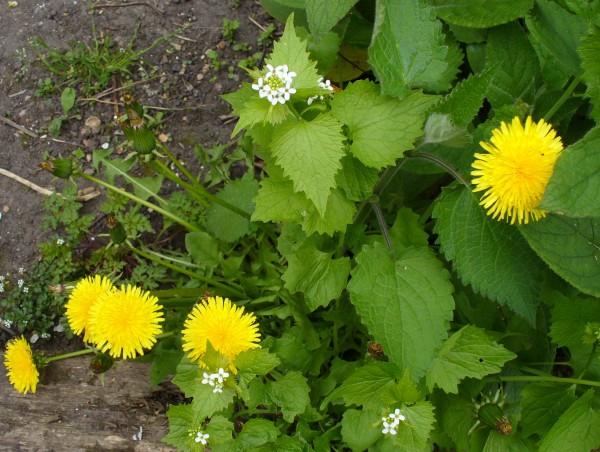   16th century Herbalist Matthiolus: “Magicians say that if a person rubs himself all over with (the decoction of the whole plant), he will everywhere be welcome and obtain what he wishes” (!) 16th century Herbalist Matthiolus: “Magicians say that if a person rubs himself all over with (the decoction of the whole plant), he will everywhere be welcome and obtain what he wishes” (!)
Nature’s Forgotten Folklore: Myths and Magic in Islington, Richard Meyers “The ingratitude shown to the dandelion is almost unbelievable. We should be inviting it in to our gardens with low bows, rather than uprooting it with imprecations. Few gardeners take note of that word officinale, which points to the fact that the dandelion should be treated with respect as a herb used in medicine. Perhaps if we mentioned in passing to our neighbours that our Taraxacums were doing well this year, we might do a little to reinstate what is, after all, quite a handsome flower. But no, its old-fashioned names of Piss-a-bed in the United States and England, and Pissenlit in France, would rise, a guilty secret from the past, to SMIRCH its already tarnished good name…” “Dandelion wine is famous for its potency, but dandelion coffee is, well, dandelion coffee.” Green Magic – Flowers, Plants and Herbs in Lore and Legend, Lesley Gordon Butterflies (Peacock, Speckled Wood, Orange Tip and Brimstone) visit the Dandelion for its nectar, as do other insects. The flowers close overnight, or during rain. |
|
 |

GARLIC MUSTARD (Alliaria petiolata)Fresh green leaves of Garlic Mustard, also known as Jack-by-the-Hedge, give way in April and May to small WHITE flowers. These are followed by pods bearing many tiny seeds, which are easily scattered by wind. Garlic Mustard is a food plant for the Orange Tip Butterfly. The female Orange Tip tastes the plant with her feet, then lays a single egg. The larva are carnivorous, so each is given its own plant; they feed on the flowers and seedpods. “For those who like garlic, but only in moderation, Jack-by-the-Hedge is ideal as a flavouring. When bruised or chopped the leaves give off just a suspicion of the smell of its unrelated namesake… the leaves, finely chopped, can be added to salads.” FOOD FOR FREE, Richard Mabey, Harper-Collins, 2004. One Garlic Mustard plant, from a wildflower sale at the Ecology Centre, was planted in the Wildlife Garden a few years ago. The following spring three plants appeared, and we have had Jack-by-the-Hedge ever since. Be warned: the prolific supply of seeds can blanket your garden with Garlic Mustard. Here, the fresh young leaves are food for slugs and snails; frogs, thrushes or blackbirds can enjoy the subtle flavouring of garlic with their next meal of slug or snail. |
HEDGE BINDWEED (Convolvulus arvensis)
The flowers of this vigorous climber may be handsome, but Hedge Bindweed’s habit of smothering everything in its path does not endear it to gardeners. Digging out its root system will be labour lost if any piece of it is left; a new plant will grow from that piece. Horwood says it is ’emblematic of obstinacy’, with folknames of ‘Devil’s Guts’ and ‘Devil’s Garter’. Charlotte Voake gives one of its names as ‘Hedge-Strangler’. In our Wildlife Garden it comes through from next door’s concrete garden, where vegetation is cut back once a year. This year more of it was allowed to climb and flower on our side, to encourage the Plume Moths to reappear. |
HEDGE WOUNDWORT (Stachys sylvatica)
Hedge Woundwort has no problems with dense shade or London Clay: small plantlets are easily pulled up and replanted elsewhere. Shiny black seeds in groups of four nestle in green tufts along its stems. “Once the seed is dispersed, the plant spreads vigorously, using its underground rhizomes.” http://www.wildlifetrusts.org.uk/species/hedgewoundwort When the flowers are done, cutting stems back by half may prolong the plant’s season, bringing on fresh leaves, further flowers, and more bees. Hedge Woundwort has been used to control bleeding, ease fevers and mitigate intestinal complaints. The many offspring of our first Hedge Woundwort, which came from an Ecology Centre wildflower sale, reappear each spring. They bring in the bees and give the garden the feeling of a woodland glade. |
|
HONEYSUCKLE (Lonicera periclymena)
RHS Encyclopedia of Herbs and Their Uses, Demi Bown The Honeysuckle, known as Woodbine, is enjoyed in the countryside now as it has been for centuries: ‘Oh how sweete and pleasant is Woodbinde, in Woodes or Arbours, after a tender soft rayne, and how friendly doth this herbe if I may so name it, imbrace the bodies, armes, and braunches of trees wyth his long winding stalkes and tender leaves, opening or spreading forth his sweete Lillies, like ladies fingers, among the thornes or bushes.’ Bulwarke of defence against all sicknesse, soareness, and woundes that doe dayly assault mankinde, gathered and practised by William Bullein, Doctor of Physicke, 1562, London. Green Magic – Flowers, Plants & Herbs in Lore & Legend, Lesley Gordon |
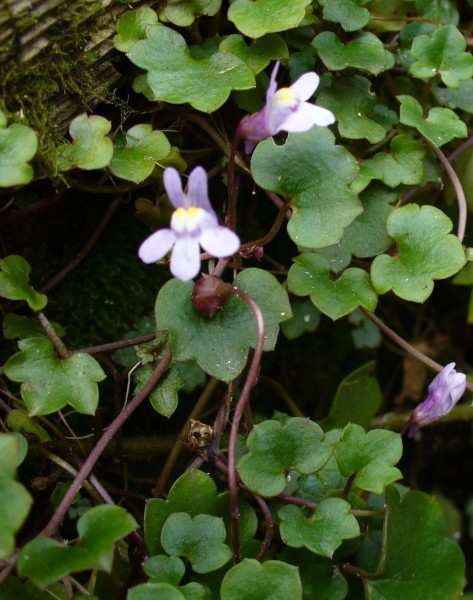
IVY-LEAVED TOADFLAX (Linaria Cymbalaria)Now a resident UK wildflower, this dainty plant from southern Europe was brought to the Chelsea Physic Garden over 300 years ago. It grows on old walls, in dry rocky places, between paving stones. Its glossy leaves are purple underneath; in full sun, stem, stalks and flower bases are tinged with purple. The flowers, tiny LILAC snapdragons, bloom from May to September. In The Secret Life of Plants, David Attenborough describes how the flowers turn to the wall on which they grow to disperse their seeds. In Reading the Landscape of Europe, May Theilgaard Watts calls it Runes-de-Rome: “This plant is a part of every medieval city wall.’ in France, “Clinging to the massive masonry that lifts Chateaudun above the Loire Valley, it undoubtedly felt the breath of molten lead poured on the enemy from the apertures above and received many a misdirected arrow from below.” After its introduction into Britain it climbed the walls of Kenilworth Castle so vigorously that it earned the name ‘Kenilworth Ivy’. Ivy-Leaved Toadflax can be persuaded to grow indoors, in a pot on a windowsill. Its self-seeding mechanism can eventually provide nearby pots with a decorative miniature groundcover. Other names: Aaron’s Beard, Climbing Sailor, Pedlar’s Basket, Penny Wort, Thousand Flower and Rabbits.
|
KNAPWEEDMasses of dry, dusty brown buds form at the stem-tips of this native perennial. In July, these become small LAVENDER ‘shaving brushes’. They usually only last until late August here, but each flower is a magnet for bees, moths, hoverflies and butterflies, including the Brimstone. Folknames include Bunds, Horse Knot, Ironweed, Lady’s Cushion, Yronhard. |
LEMON BALM/BEE BALM ( Melissa officinalis) – Europe to C. Asia
GROW YOUR OWN DRUGS, James Wong, Collins, 2009. Plant Lemon Balm beside a path, or somewhere it can enjoy human contact, and vice versa. Cultivated for over 2,000 years, tea brewed from its leaves is therapeutic, soothing away melancholy and reviving the tired brain. ‘Nothing but good can be said of this rather insignificant-looking and unassuming herb. It is a valuable bee plant, and, according to Pliny, acted as a sort of sign-post, in case any bee was in danger of getting lost. “Bees are delighted with this herbe above all others… when they are straid away, they do finde their way home againe by it.” ‘The leaves of balm are still rubbed inside the hives after the hiving of a new swarm, to encourage the newcomers to stay.’ Green Magic – Flowers, Plants and Herbs in Lore and Legend, Lesley Gordon |
|

|
 
‘…flowery tops contain Salicylic acid – nature’s aspirin’. In 1897, chemists at Bayer produced synthetically altered salicin, which helps alleviate fever, headache and pain. They named it Aspirin (acetyl + spiraea ulmaria) after the plant’s earlier botanical name, Spiraea ulmaria. www.indianmirror.com meadowsweet.html, an Ayurvedic website [hana-flv-player |
PURPLE LOOSESTRIFE (Lythrum salicaria)
A wildflower of wet ground, Purple Loosestrife can be found at the edges of ponds, rivers and ditches. Its elegant spires of MAGENTA-PURPLE flowers bloom from June to August. Our stand of Purple Loosestrife, from a wildflower sale at the Ecology Centre, grows in the damp shade of the Fern Bed. Bumblebees love it. |
  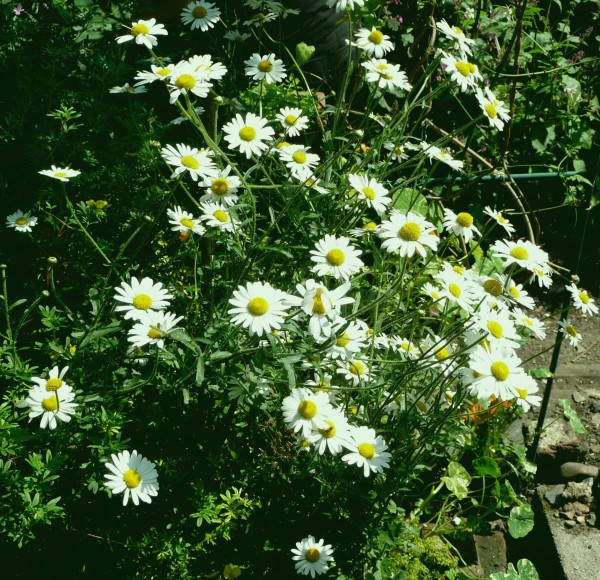
|
 
|

SELF-HEAL (Prunella vulgaris)
Folknames: Herb Carpenter, Heart of the Earth, London Bottles, Pick Pocket, Prince’s Feather, Sicklewort. Valued as a herb for treating wounds and sore throats; in North America, where it was taken by early settlers, it is called ‘Woundwort’. “Prunella vulgaris has a long history of use in traditional medicine. It was first mentioned in Chinese medical literature during the Han dynasty (206BC-AD23), mainly for complaints associated with disturbed liver energy. European herbalists have always regarded it primarily as a wound herb”. RHS Encyclopedia of Herbs & Their Uses, Demi Bown, p. 335 Botanical painting by J.N.Fitch, Horwood’s British Wildflowers in Their Favourite Haunts, 1919 |

SMALL SCABIOUS (Scabiosa Columbaria)LAVENDER pincushion flowers of this wildflower are produced throughout the summer; bees are all over it. It loves sunshine and good drainage, and is a valued nectar plant for butterflies such as the Comma. 2012’s heavy rains brought an early end to its flowering season here. It can be dwarfed by robust plants climbing over it or taking its sunshine. Small Scabious was formerly used to treat afflictions of the skin, from scabies to bubonic plague. [hana-flv-player |
|
|
VIPER’S BUGLOSS (Echium vulgare)A tall plant with flowers of a deep, vivid BLUE, Viper’s Bugloss likes dry, gritty soil. One was planted here in a large terracotta pot with a Teasel and a Wild Clary; the Teasel took over, crowding out the others. Once replanted, Viper’s Bugloss proved a magnet for bees. As for how it got its name, a website called www.honeytraveler.com, which looks at honey worldwide, shows photos of Viper’s Bugloss seeds that show the perceived resemblance between the seed and a viper’s head… Echium is a Latin word taken from the Greek ‘echis’ for viper; ‘bugloss’ is Greek for ox tongue, referring to the roughness and shape of the plant’s leaves. Its other names include Blue Bottle, Blue Cat’s Tail, Our Saviour’s Flannel, Blue Thistle and Blue Devil. |
|
|
|
|
* Imprint, Transworld Publishers * Div. of the Random House Group Ltd. * www.kidsatrandomhouse.co.uk * www.edenproject.com This little book, by award-winning children’s book illustrator Charlotte Voake, can be enjoyed by adults as well as children. Each native wildflower is illustrated, with a small, hand-printed tale of where it grows, when it flowers, how it got its name, and its past history with humans… has it fed us, healed us or poisoned us? Birds, animals, insects and children appear throughout. The selection of native plants includes Chickweed, Milkwort and Shepherd’s Purse… small and easily overlooked by many of us. Pages left blank at the back ( ‘My Wild-Flower Scrapbook’ ) are meant for drawings, paintings or photos of wildflowers: ‘Make sure you date all your entries – this could be a useful document one day!’ “The Eden Project brings plants and people together. It is dedicated to developing a greater understanding of our shared global garden, encouraging us to respect plants – and to protect them.” Nature’s Forgotten Folklore: Myths and Magic in Islington * Richard Meyers * In this booklet for Islington Council, Conservation Ranger Richard Meyers collects some of the stories, folknames and legends surrounding our local wildlife… There are traditions from a rural way of life before the industrial revolution, and tales from other countries who share some of our flora and fauna. Those who have come along on one of Richard’s guided walks, or joined him and the team on a Thursday Volunteer Day, will have heard these and other stories. In Nature’s Forgotten Folklore: Myths and Magic in Islington he is, as he says, merely scratching the surface. The book is available free, while stocks last, from The Islington Ecology Centre, 191 Drayton Park, London N5 1PH (By personal visit rather than by post.) Wildflowers in the Ecology Centre’s sales have come from Norfolk: *British Wildflower Plants * www.wildflowers.co.uk * 01603 716 615 Wildflower biography sketches are from ‘Imagine Islington‘, a Millenium display for the Angel Mall organised by the Islington Ecology Centre. Hay bales divided walkway areas; wildflowers were planted in all manner of containers, from old boots to shopping trolleys. There were houses for wildlife (Who Lives Here? – bats, hedgehogs, frogs and toads) and games, with Wildlife Rangers on hand to answer questions. For information and inspiration: see Marc Carlton’s website http://www.foxleas.com/PDF/Gardening%20for%Bumblebees07.pdf (c) 2007 ‘The Pollinator Garden’ http://ww.buglife.org/uk/Resources/Buglife/Suggested flowers for bumblebees.pdf (includes ‘generally not much good for bumblebees’) …………………………………………………………………………………………………………………………………………………………. The Country Diary of an Edwardian Lady, published by Michael Joseph in 1977, was created by naturalist, illustrator and art teacher Edith Holden in 1905-06. Edith painted the wildflowers, birds and other wildlife she saw, walking or cycling through countryside around her home in Orton, Warwickshire. The book moves through the seasons, pages filled with botanical paintings, country traditions, poems, the weather… Cycling was popular; many women, laced into the tight corsets and long dresses of the Victorian era, now chose to wear ‘rational dress’, such as loose-fitting trousers (knickerbockers) for cycling. Some men objected… only eight years earlier, male students at Cambridge had hanged a woman riding a bicycle, in effigy, to protest the admission of women to the college. It is our good fortune that Edith Holden was able to cycle into the countryside and record what she saw there. In this book we see it as it was a century ago, through her eyes. www.morningearth.org/ARTISTNATURALISTS/AN_Holden.html |







